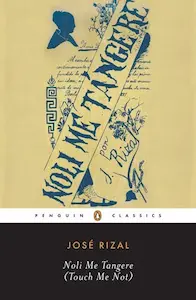Noli Me Tangere - Summary
Jose Rizal

Introduction
“Noli Me Tangere” is a renowned novel written by Jose Rizal, a Filipino national hero. This literary masterpiece, published in 1887, sheds light on the social and political issues prevalent during the Spanish colonization of the Philippines. Rizal’s novel explores the injustices and abuses suffered by the Filipino people under Spanish rule, and it serves as a catalyst for inspiring nationalistic sentiments and sparking the revolution against colonial oppression. Through vivid storytelling and compelling characters, Rizal effectively portrays the harsh realities faced by his countrymen, ultimately urging them to fight for their freedom and justice.
The Setting: A Glimpse into Colonial Philippines
Rizal’s “Noli Me Tangere” is set in the 19th-century Philippines, during the Spanish colonization period. The story takes place in the fictional town of San Diego, a microcosm of the larger society. Through this setting, Rizal paints a vivid picture of the social hierarchy, corruption, and abuses that plagued the country under Spanish rule.
The Protagonist: Crisostomo Ibarra
The novel revolves around the life of Crisostomo Ibarra, the protagonist and a young Filipino educated in Europe. Upon his return to the Philippines, Ibarra seeks to bring progress and reforms to his hometown. He represents the idealistic and enlightened Filipino who aspires to uplift his countrymen from poverty and ignorance.
The Antagonist: Padre Damaso
Padre Damaso, a Spanish friar, serves as the primary antagonist in “Noli Me Tangere.” He symbolizes the oppressive and corrupt Spanish clergy who exploit the Filipino people for their own gain. Padre Damaso’s character embodies the arrogance and abuse of power that Rizal criticizes throughout the novel.
Themes of Love, Betrayal, and Social Injustice
Rizal skillfully weaves various themes into the narrative of “Noli Me Tangere.” Love, betrayal, and social injustice are prominent themes that resonate throughout the story. The novel explores the forbidden love between Crisostomo Ibarra and Maria Clara, the daughter of Padre Damaso. Their love story becomes a metaphor for the forbidden desire for freedom and justice that the Filipino people yearn for.
An Exploration of Social Classes
Rizal delves deep into the social classes prevalent in colonial Philippines. He exposes the stark contrast between the wealthy and influential Spanish friars and the impoverished Filipino masses. Through vivid descriptions and character interactions, Rizal highlights the vast disparities in wealth, education, and opportunities, which further fuel the discontent and desire for change among the Filipino people.
Unmasking Corruption and Hypocrisy
Corruption and hypocrisy are pervasive themes in “Noli Me Tangere.” Rizal exposes the immoral practices of the Spanish friars and their manipulation of the justice system. He reveals the clergy’s double standards, as they preach piety and virtue while engaging in immoral acts behind closed doors. Through the character of Padre Damaso, Rizal unveils the dark side of the Spanish clergy, igniting a sense of outrage among readers.
Symbolism and Imagery
Rizal masterfully employs symbolism and imagery to enhance the impact of his narrative. The title itself, “Noli Me Tangere,” translates to “Touch Me Not” in Latin and serves as a metaphor for the oppressed Filipinos’ desire to break free from Spanish oppression. Rizal also uses vivid descriptions of nature and landscapes to reflect the characters’ emotions and the societal atmosphere, creating a rich and immersive reading experience.
The Power of Education and Enlightenment
Throughout the novel, Rizal emphasizes the importance of education and enlightenment in bringing about social change. Crisostomo Ibarra’s education in Europe shapes his perspective and fuels his desire to uplift his countrymen. Rizal highlights the transformative power of knowledge and the need for Filipinos to be educated to break free from the chains of ignorance and oppression.
The Call for Revolution
“Noli Me Tangere” serves as a call to action for the Filipino people. Rizal’s novel exposes the injustices and abuses suffered under Spanish rule, urging his countrymen to rise up and fight for their rights. The novel’s publication played a significant role in awakening nationalistic sentiments among Filipinos and ultimately paved the way for the Philippine Revolution against Spanish colonialism.
Conclusion
Jose Rizal’s “Noli Me Tangere” remains a timeless masterpiece that continues to captivate readers with its powerful storytelling and thought-provoking themes. Through the use of vivid characters and compelling narratives, Rizal effectively sheds light on the social injustices and abuses prevalent during the Spanish colonization of the Philippines. The novel’s enduring impact lies in its ability to inspire and ignite a sense of nationalistic pride among Filipinos, ultimately leading to the fight for freedom and justice. “Noli Me Tangere” stands as a testament to Rizal’s literary genius and his unwavering commitment to the Filipino people’s welfare.